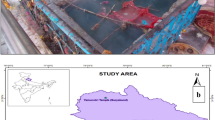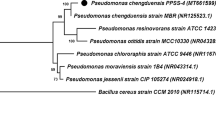Abstract
The focus of the present study is to isolate and identify magnetotactic bacteria from fresh water sediments in Salem region, Tamil Nadu. Fresh water sediments were collected and characterized by X-ray diffraction to detect the crystalline nature of particles. Totally 12 isolates were screened for the metal biosorption efficiency in modified nutrient agar plates with 10 mg (lower concentration) of four different metals viz., manganese chloride, zinc sulphate, copper sulphate and potassium dichromate. Followed by testing their ability to tolerate higher concentration of metals viz., 20 mg, 30 mg, 50 mg, 70 mg, 90 mg and 150 mg/50 ml was analyzed. Only four bacteria survived the highest concentration of manganese and zinc (3000 µg/ml), CuSO4 and K2Cr2O7 at a concentration of 1400 µg/ml and 1800 µg/ml, respectively. The four bacterial strains Stenotrophomonas maltophilia, two Pseudomonas aeruginosa strains and Achromobacter xylosoxidans were grown in modified nutrient broth (NB) and Luria Bertani (LB) incorporated with metals such as manganese, zinc, copper and chromium and tested for their efficacy to sustain metal stress. Since the two bacterial strains (SBY and KY1) were able to grow in both medium with a potential to with stand higher metal concentration these strains were further studied. A metal tolerant magnetotactic bacterial strain Pseudomonas aeruginosa SBY was confirmed by TEM analysis to detect the accumulated metal within the cell. As bacterial strains were capable of tolerating higher concentration of metal, they may have a vital role in environmental bioremediation.






Similar content being viewed by others
Data availability
Data sharing not applicable to this article as no datasets were generated or analyzed during the present study.
References
Ambiganandham K, Sudhakaran MR, Narayanan KR, Jeyachandran M (2015) Preliminary report on the isolation of magnetotactic bacteria from river tamiraparani in south India. Biology 1:12–14
Blakemore RP, Maratea D, Wolfe RS (1979) Isolation and pure culture of a freshwater magnetic spirillum in chemically defined medium. J Bacteriol 140:720–729
Blakemore RP, Short KA, Bazylinski DA, Rosenblatt C, Frankel RB (1985) Microaerobic conditions are required for magnetite formation within Aquaspirillum magnetotacticum. Geomicrobiol J 4:5371. https://doi.org/10.1080/01490458509385920
Boulygina ES, Kuznetsov BB, Marusina AI, Tourova TP, Kravchenko IK, Bykova SA, Kolganova TV, Galchenko VF (2002) A study of nucleotide sequences of nifH genes of some methanotrophic bacteria. Microbiology 71:425–432
Burakov AE, Galunin EV, Burakova IV, Kucherova AE, Agarwal S, Tkachev AG, Gupta VK (2018) Adsorption of heavy metals on conventional and nanostructured materials for waste water treatment purposes: a review. Ecotoxicol Environ Saf 14:8702–8712
De J, Ramaiah N, Vardanyan L (2008) Detoxification of toxic heavy metals by marine bacteria highly resistant to mercury. Mar Biotechnol 10:471–477
Dhanwal P, Kumar A, Dudeja S, Badgujar H, Chauhan R, Kumar A, Dhull P, Chhokar V, Beniwal V (2018) Biosorption of heavy metals from aqueous solution by bacteria isolated from contaminated soil. Water Environ Res 90:424–430
Faivre D, Menguy N, Pósfai M, Schüler D (2008) Environmental parameters affect the physical properties of fast-growing magnetosomes. Am Miner 93:463–469
François F, Lombard C, Guigner JM, Soreau P, Brian-Jaisson F, Martino G, Vandervennet M, Garcia D, Molinier AL, Pignol D, Peduzzi J (2011) Isolation and characterization of environmental bacteria capable of extracellular biosorption of mercury. Appl Environ Microbiol 78:1097–1106
Ge S and Ge SC (2016) Simultaneous Cr (VI) reduction and Zn (II) biosorption by Stenotrophomonas sp. and constitutive expression of related genes. Biotechnol Lett 38:877–884
Islam MS, Ahmed MK, Raknuzzaman M, Habibullah-Al-Mamun M, Islam MK (2015) Heavy metal pollution in surface water and sediment: a preliminary assessment of an urban river in a developing country. Ecol Indic 48:282–291. https://doi.org/10.1016/j.ecolind.2014.08.016
Kabary H, Eida MF, Attia MM, Awad N, Easa SM (2017) Magnetotactic characterization and environmental application P. aeruginosa kb1 isolate. Annu Res Rev 18:1–10
Kumar S, Stecher G, Tamura K (2016) MEGA7: molecular evolutionary genetics analysis version 7.0 for bigger datasets. Mol Biol Evol 33:1870–1874
Kundu S, Kulkarni GR (2010) Enhancement of magnetotactic bacterial yield in a modified MSGM medium without alteration of magnetosomes properties. Indian J Exp Biol 48:518–523
Lefèvre CT, Schmidt ML, Viloria N, Trubitsyn D, Schüler D, Bazylinski DA (2012) Insight into the evolution of magnetotaxis in magnetospirillum sp. based on mam gene phylogeny. Appl Environ Microbiol 78:7238–7248
Lefevre CT, Viloria N, Schmidt ML, Posfai M, Frankel RB, Bazylinski DA (2012) Novel magnetite-producing magnetotactic bacteria belonging to the gammaproteobacteria. ISME J 6:440–450
Li W, Yu L, Zhou P, Zhu M (2007) A magnetospirillum strain WM-1 from a freshwater sediment with intracellular magnetosomes. World J Microb Biot 23:1489–1492
Li X, Li D, Yan Z, Ao Y (2018) Biosorption and bioaccumulation characteristics of cadmium by plant growth-promoting rhizobacteria. RSC Adv 8:30902–30911
Mustapha MU, Halimoon N (2015) Screening and isolation of heavy metal tolerant bacteria in industrial effluent. Procedia Environ Sci 30:33–37
Oves M, Khan MS, Zaidi A (2013) Biosorption of heavy metals by Bacillus thuringiensis strain OSM29 originating from industrial effluent contaminated north Indian soil. Saudi J Biol Sci 20:121–129
Pi F, Sun J, Liu W, Sun X, Zhang Y (2017) Elimination of aflatoxin B1 in vegetable oil based on immuno-magnetosomes probes from a novel magnetotactic bacterium. Food Control 80:319–326
Revathy T, Jacob JJ, Jayasri MA, Suthindhiran K (2016) Isolation and characterization of Magnetospirillum from saline lagoon. World J Microb Biot 32:109
Ryan RP, Monchy S, Cardinale M, Taghavi S, Crossman L, Avison MB, Berg G, Van Der Lelie D, Dow JM (2009) The versatility and adaptation of bacteria from the genus Stenotrophomonas. Nat Rev Microbiol 7:514–525
Salazar A, Morales A, Marquez M (2011) Characterization of natural microcosms of estuarine magnetotactic bacteria. Dyna 78:72–80
Singh N, Verma T, Gaur R (2013) Detoxification of hexavalent chromium by an indigenous facultative anaerobic Bacillus cereus cereus strain isolated from tannery effluent. Afr J Biotechnol 12:1091–1103
Singh R, Ahmed T, Bamola N, Singh R (2018) Isolation and characterization of magnetotactic bacteria collected from northern India: a preliminary study. J Pure Appl Microbiol 12:713–720
Song HP, Li XG, Sun JS, Xu SM, Han X (2008) Application of a magnetotactic bacterium, Stenotrophomonas sp. to the removal of Au (III) from contaminated wastewater with a magnetic separator. Chemosphere 72:616–621
Sun JB, Zhao F, Tang T, Jiang W, Tian JS, Li Y, Li JL (2008) High-yield growth and magnetosome formation by Magnetospirillum gryphiswaldense MSR-1 in an oxygen-controlled fermentor supplied solely with air. Appl Microbiol 79:389–397
Tamura K, Peterson D, Peterson N, Stecher G, Nei M, Kumar S (2011) MEGA5: molecular evolutionary genetics analysis using maximum likelihood, evolutionary distance, and maximum parsimony methods. Mol Biol Evol 28:2731–2739
Taoka A, Kondo J, Oestreicher Z, Fukumori Y (2014) Characterization of uncultured giant rod-shaped magnetotactic Gamma proteobacteria from a freshwater pond in Kanazawa, Japan. Microbiology 160:2226–2234
Wang W, Pan C, Chen F, Cheng J (2011) Copper (II)-catalyzed ortho-functionalization of 2-arylpyridines with acyl chlorides. Chem Commun 47:3978–3980
Wang X, Huang N, Shao J, Hu M, Zhao Y, Huo M (2018) Coupling heavy metal resistance and oxygen flexibility for bio removal of copper ions by newly isolated Citrobacter freundii JPG1. J Environ Manag 226:194–200
Whitman WB, Rainey F, Kampfer P, Trujillo M, Chun J, DeVos P, Hedlund B, Dedysh S, Nedashkovskaya OI (2016) Bergey's manual of systematics of Archaea and Bacteria, pp 1–4
Ye J, Yin H, Xie D, Peng H, Huang J, Liang W (2013) Copper biosorption and ions release by Stenotrophomonas maltophilia in the presence of benzo[a]pyrene. Chem Eng J 219:1–9
Zargoun LM, Zain NAM, Shahir S (2016) Characterization of cultured Rod-shaped magnetotactic beta proteobacteria from skudai river, Malaysia. Indian J Sci Technol 9:1–9. https://doi.org/10.17485/ijst/2016/v9i47/107116
Acknowledgements
The authors would like to thank Periyar University for providing laboratory facilities and university research fellowship to perform this research work. The authors also sincerely show gratitude to DST-FIST, New Delhi, India for granting sophisticated instrumentation with reference No. SR/FST/LSI-640/2015 (C) dated 30/5/2016.
Funding
The authors thank Periyar University, Salem for Providing University research fellowship to carry out this research work and the authors also sincerely show gratitude to DST-FIST, New Delhi, India for granting sophisticated instrumentation facility with reference No. SR/FST/LSI-640/2015 (C) dated May 30, 2016.
Author information
Authors and Affiliations
Contributions
Dr. R. Dhandapani and Dr. J. Jamunadevi conceived and designed the experiments. Dr. J. Jamunadevi performed the experimental analysis. Dr. R. Dhandapani analyzed the data, provided resources for the research work and Dr. S. Santhosh contributed with statistical analysis and interpretation of data.
Corresponding author
Ethics declarations
Ethical approval
This study is on isolation of fresh water bacteria and its applications, no ethical approval was obtained as there were no human/animal participants involved in this study.
Conflict of interest
The authors declare that they have no competing interests to share on this research.
Consent to participate
I Dr. Dhandapani Ramamurthy along with all coauthors agree to participate in this research study.
Consent to publish
The author accepts responsibility to publish this paper if accepted on behalf of all co-authors.
Additional information
Communicated by Erko Stackebrandt.
Publisher's Note
Springer Nature remains neutral with regard to jurisdictional claims in published maps and institutional affiliations.
Supplementary Information
Below is the link to the electronic supplementary material.
Rights and permissions
About this article
Cite this article
Jayaraman, J., Sigamani, S. & Ramamurthy, D. Metal biosorption by magnetotactic bacteria isolated from fresh water sediments and characterization of extracted magnetosomes. Arch Microbiol 203, 5951–5962 (2021). https://doi.org/10.1007/s00203-021-02534-w
Received:
Revised:
Accepted:
Published:
Issue Date:
DOI: https://doi.org/10.1007/s00203-021-02534-w




